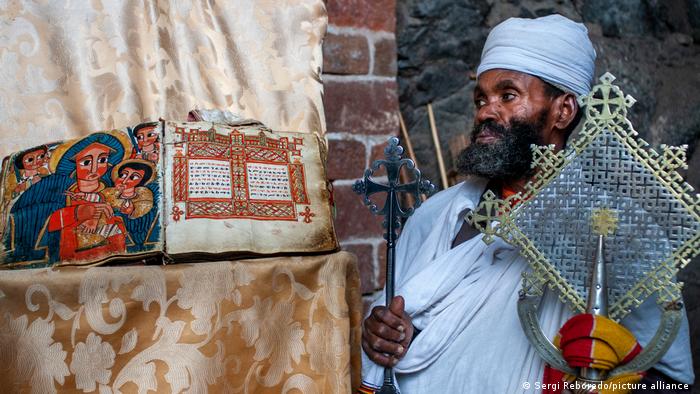
Ethiopia’s War Endangers Ancient Relics
Experts have noticed a surge in online sales of Ethiopian artifacts. They fear these relics could have been looted during Ethiopia’s ongoing civil war.
Source: DW
March 10, 2022
Many Ethiopians were shocked when the news spread that Ethiopian antiquities could be bought on the online marketplace eBay, as well as on other trading sites.
The items listed for sale included centuries-old scrolls and Christian Orthodox bibles, often offered at below-market prices.
One antique manuscript cost just €688 ($754).
Manuscript expert Hagos Abrha Abay, an Ethiopian academic based in Germany, was one of the first to draw attention to the eBay listings when he tweeted screenshots in February highlighting the breadth of Ethiopian antiquities on offer.
eBay has since removed from their listings a number of Ethiopian artifacts that lack evidence of provenance.
Real or fakes
It is impossible to ascertain from photographs accompanying online listings whether the items are real or fakes — experts have warned for years about the flood of fraudulent antiques posted to eBay and other online sites.
Ethiopia’s government, however, believes the items are probably authentic and has sought help to trace them and get them back.
“Without question, the artifacts are Ethiopia’s heritage,” Ethiopia’s Tourism State Minister, Sileshi Girma, told DW.
Many of the items appear to originate in areas designated as UNESCO World Heritage sites.
He said Ethiopian officials were in contact with UNESCO about the listed items: “We will keep working … to bring back our heritage to Ethiopia. UNESCO will also retrieve the objects from the eBay marketplace.”
War plunder?
There are strong suspicions that numerous Ethiopian antiquities being offered online have been looted during the country’s ongoing civil war between government forces and Tigray fighters, now in its 15th month.
Experts have been warning for more than a year of the plundering of churches, monasteries, mosques and museums in Tigray and neighboring regions in Ethiopia’s north.

While the international airport in the capital Addis Ababa has strict controls, it is a different situation at many of Ethiopia’s border checkpoints, and “people could get away with various things,” government official Sileshi admitted.
The conflict also makes it to keep track of religious and cultural artifacts.
Damage and losses unknown
Prominent Ethiopian heritage analyst Henok Seyoum told DW that he had personally witnessed damaged cultural sites in the nation’s north.
“There has been great destruction and looting in this war,” Henok said. “It is still raging in the north and as a result, it is impossible to visit heritage sites even in Tigray.”
Alebachew Desalegn, a London-based private collector of Ethiopian artifacts, is among those who find it plausible that the artifacts were plundered during the war.
“Heritage shows your roots. Heritage shows the history of the country. A campaign against heritage in Ethiopia is itself part of the war,” Desalegn said. “This is unacceptable.”
He accused the federal government of turning a blind eye to the destruction and theft of the country’s priceless heritage throughout the conflict.
“The [Tourism] Ministry must examine all cultural sites that have been looted and report to the Ethiopian people,” he said. “The government must ensure also the return of relics that were looted and taken abroad. It has shown no interest in this issue. It is very sad.”
Tourism State Minister Sileshi Girma told DW that his office is looking into the extent of the destruction and looting and will make its findings public soon.

Ethiopia’s myriad artefacts
Compounding the difficulties of tracing such objects is the sheer volume of Ethiopia’s historical objects. One estimate is that the libraries and archives of Ethiopia’s monasteries containsome 200,000 ancient manuscripts.
On top of this, Ethiopia’s artifacts have long been bought and sold, and as a result, are spread widely throughout the globe.
“Ethiopia is an ancient state … It was the first country with a port on the Red Sea that had a navy and control from the port of Sudan to the Indian Ocean. Ethiopia traded with Egypt, Persia, India and the Greco-Roman Empire,” said Yohannes Zeleke, a member of the International Restitution Committee for Ethiopian Heritage, who is also a researcher at the Smithsonian Museum in the United States.
For Zeleke, having Ethiopian heritage in museums around the world is one thing. But dubious sales of the country’s antiquities to private individuals is a different story.
“Having Ethiopia’s heritage in the hands of individuals, it is worrying,” he said.
The most important thing now, says Zeleke, is to find out whether the artifacts listed on eBay are real or duplicates.
Until that is known, “we shouldn’t panic,” he said.
